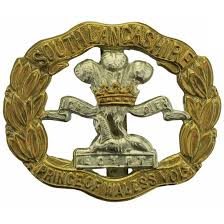Personal Details
Born: 13 January 1884 in Whitchurch, Shropshire and baptised 30 March the same year in Whitchurch Wesleyan Methodist Chapel.
Family: He was the second of four children born to Benjamin Blyth Powell, a general labourer, and his wife Martha. Benjamin married again to Charlotte Ann Ellson in 1899. Thomas Frederick married Emily Hayward on 28 December 1905 in Hanmer Parish Church, Flintshire, Wales and together they had four children – Frank, Frederick, Alice and Ethel. Emily had two children from a previous relationship who lived with them – Albert and Edith.
Residence: In 1901 he was boarding in Whitewell Lane, Iscoyd, Flintshire. By 1911 and now married he lived at The Smithy Cottage, Black Park, Whitchurch, Shropshire and when he enlisted in 1916 and was discharged in 1919 his address was 1 Venable’s Yard, Whitchurch. In 1939 he lived at 23 Rosemary Lane, Whitchurch where he continued to live until the time of his death.
Employment: In 1911 he was a farm waggoner; in 1939 he was a general farm worker.
Died: In 1943 in Whitchurch, Shropshire, aged 59, and was buried on 4 September the same year in Whitchurch cemetery.
Military Details
Regiment: South Lancashire Regiment
Rank: Private
Service Number: 242645 (previously 5493)
Date of Enlistment: 19 October 1916
Date of Discharge: 7 March 1919
Reason for Discharge: Demobilisation
Other Information: Thomas was entitled to wear a wound stripe.
Thomas was awarded the Campaign Medals (British War Medal and Victory Medal)

The British War Medal (also known as 'Squeak') was a silver or bronze medal awarded to officers and men of the British and Imperial Forces who either entered a theatre of war or entered service overseas between 5th August 1914 and 11th November 1918 inclusive. This was later extended to services in Russia, Siberia and some other areas in 1919 and 1920. Approximately 6.5 million British War Medals were issued. Approximately 6.4 million of these were the silver versions of this medal. Around 110,000 of a bronze version were issued mainly to Chinese, Maltese and Indian Labour Corps. The front (obv or obverse) of the medal depicts the head of George V. The recipient's service number, rank, name and unit was impressed on the rim.
The Allied Victory Medal (also known as 'Wilfred') was issued by each of the allies. It was decided that each of the allies should each issue their own bronze victory medal with a similar design, similar equivalent wording and identical ribbon. The British medal was designed by W. McMillan. The front depicts a winged classical figure representing victory. Approximately 5.7 million victory medals were issued. Interestingly, eligibility for this medal was more restrictive and not everyone who received the British War Medal ('Squeak') also received the Victory Medal ('Wilfred'). However, in general, all recipients of 'Wilfred' also received 'Squeak' and all recipients of The 1914 Star or The 1914/1915 Star (also known as 'Pip') also received both 'Squeak' and 'Wilfred'. The recipient's service number, rank, name and unit was impressed on the rim.

